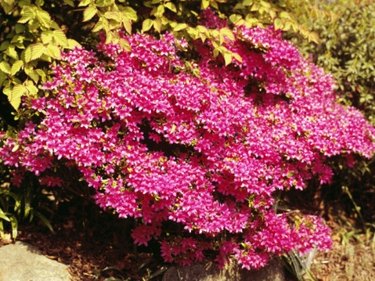Things You'll Need
Shears
Spade
Fungicide

Shrubs or bushes are woody plants, varying in height from a few inches tall to as high as 15 feet. Shrubs also usually have multiple trunks, which helps to differentiate the tall ones from trees. Like every plant, shrubs are susceptible to diseases, including fungal infections. Each infection requires specific treatment, so be sure you have correctly identified the source of infection before you begin a treatment regimen. Contact your local cooperative extension office for help with accurate identification.
Step 1
Treat twig blight, which causes leaf drop and dead branches, by removing and discarding dead stems. As you cut through the wood, dip your shears in a solution of one part bleach and nine parts water to prevent infection of healthy tissue.
Video of the Day
Step 2
Uproot shrubs affected by mushroom root rot to stop the disease from spreading to other bushes. Remove and discard the diseased shrubs' stumps and roots.
Step 3
Eliminate fungi that cause leaf spots in shrubs by applying a fungicide that contains chlorothalonil, fixed coppers, mancozeb, maneb or zineb. Spray the plant in early spring as the leaves are unfurling out of the buds. Repeat the treatment one to two weeks later.
Tip
Prevent fungal infections by maintaining the health of your shrub. Follow the recommended fertilization and watering schedule. Prune and discard all diseased, dead and broken branches. Plant fungus-resistant cultivars whenever one is available for the species.
Video of the Day